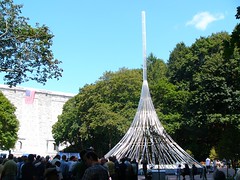 Look what I dug up. I didn't realize that I was audio blogging back in the early 90's. Ok ok, I found this here, via Gizmodo via Boing Boing.
Look what I dug up. I didn't realize that I was audio blogging back in the early 90's. Ok ok, I found this here, via Gizmodo via Boing Boing.
Thursday, September 28, 2006
Artifact
 Look what I dug up. I didn't realize that I was audio blogging back in the early 90's. Ok ok, I found this here, via Gizmodo via Boing Boing.
Look what I dug up. I didn't realize that I was audio blogging back in the early 90's. Ok ok, I found this here, via Gizmodo via Boing Boing.
Saturday, September 23, 2006
Quarks Swim Free
 Not sure how I missed this, but Elliot Sharp has a piece floating around town these days that I really should check out: "Quarks Swim Free":
Not sure how I missed this, but Elliot Sharp has a piece floating around town these days that I really should check out: "Quarks Swim Free":Quarks Swim Free is E#'s latest algorithmic piece for Orchestra Carbon. For 11 or more musicians and based on prime numbers, Quarks Swim Free creates a dense primordial soup filled with high-energy collisions, gnashing grooves, and warped melodies. Quarks Swim Free premiered at the Venice Biennale in 2003. This performance will be captured by noted documentarian Bert Shapiro for his film on E#'s work.Sounds neat, but I was intrigued where the title came from. Best I could come up with was Kenneth Chang's NYT piece (archived by Brookhaven here):
For this concert the ensemble includes Kinan Azmeh, Curtis Fowlkes, Rachel Golub, Brad Jones, Ron Lawrence, Jenny Lin, Chris McIntyre, Rudresh Mahanthappa, Kevin Ray, Danny Tunick, Alex Waterman and more
An atomic nucleus consists of protons and neutrons, which, in turn, consist of smaller particles, quarks. Quarks are held together by still another type of particle, gluons. In ordinary matter, it is impossible to pull out an individual quark or gluon.I saw Sharp play at a benefit last year, accompanying a Jenn Reeves film (thanx Jen!), and I definitely would have swung by last night (if one can swing by Carroll Gardens from the Upper West Side...), but it's Rosh Hashanah folks and Kate and I had a service to attend. Happy new years everyone!
But with hot temperatures and high pressures, physicists theorize, the gluon bindings loosen, and the quarks can swim free, melting protons and neutrons into a new state of matter, a quark-gluon plasma.
Thursday, September 21, 2006
Blow-Up
 Uh-oh, trouble in cosmologyland: Type Ia supernovae, the objects responsible for the post-1998 consensus that the universe is not just expanding, but accelerating, aren't such standard candles after all:
Uh-oh, trouble in cosmologyland: Type Ia supernovae, the objects responsible for the post-1998 consensus that the universe is not just expanding, but accelerating, aren't such standard candles after all:Now, astronomers led by Andrew Howell of the University of Toronto in Canada have found a type Ia supernova that is 2.2 times as bright as others of its class. Called SNLS-03D3bb, it lies about 3 billion light years away, a distance that was independently verified by studying the light spectrum of its host galaxy.As a student, I found it amazing that you could use brightness to measure distance. One always suspects that it's harder than it looks, but it's quite impressive that they have sufficient precision to detect outliers. Unfortunately, once everyone trying to image the dynamics of a younger universe gets on board, they're probably going to have a fun time agreeing on just who the "rogues" really are.
That brightness, along with other clues from the supernova's spectrum, suggests the white dwarf exploded with 2.1 solar masses of material – significantly above the Chandrasekhar mass. "It wasn't a little bit over – it was way over," Howell told New Scientist. "We're forced to say it's not a measurement error."
These young galaxies are found more often in the early universe, which corresponds to greater distances from Earth. "This might actually improve our precision in future studies if we identify this little subset of supernovae," says Howell.In my kind of physics, we sometimes call such things "pentaquarks". Ouch.
(Thanks to slashdot, apologies to Brian de Palma for post title...)
Monday, September 11, 2006
The Rising
Hard to believe it's been 5 years, isn't it? Long story, but I spent most of yesterday in Valhalla, NY, out in Westchester County, watching the dedication of "The Rising". This 80-foot high steel structure, designed by architect Frederick Schwartz, commemorates the 109 Westchester residents who died in the 9/11 attacks. A beautiful work, poignant and soaring -- and not absurdly expensive.
The dam itself is a beautiful object in itself, massive beyond words. All of this, plus candids of Hillary Clinton, Chuck Schumer, and a Bruce Springsteen tribute band, here in my Flickr set.
The dam itself is a beautiful object in itself, massive beyond words. All of this, plus candids of Hillary Clinton, Chuck Schumer, and a Bruce Springsteen tribute band, here in my Flickr set.
Friday, September 08, 2006
The Chelsea Particle Zoo
 As one of the seemingly-few unofficial nuclear physicists about town, I can't resist chiming in when the culture industry starts to wander into scientific territory. Kate and I cut out of work a little early yesterday to check out the endless array of Chelsea art openings. I wasn't expecting much (not following the art scene too closely, I admit) but I wasn't expecting The Particle Zoo at the Mike Weiss Gallery.
As one of the seemingly-few unofficial nuclear physicists about town, I can't resist chiming in when the culture industry starts to wander into scientific territory. Kate and I cut out of work a little early yesterday to check out the endless array of Chelsea art openings. I wasn't expecting much (not following the art scene too closely, I admit) but I wasn't expecting The Particle Zoo at the Mike Weiss Gallery.Don't get me wrong, there is enormous potential in mining scientific concepts and images. Nature throws us many things we could never have imagined until we actually look (with eyes or detectors or telescopes or models, etc.). That said, rainbows and glassy shapes don't really do it for me.
Monday, September 04, 2006
Follow the Bouncing Ball
Summer's over, folks, as is my recent vacation (to the North Fork of Long Island, Southwest Florida, and finally back to NYC). But what better way to acknowledge this fact than to sit my ass down for 6 hours to watch a lot of great tennis at the US Open. Some friends were already going and it didn't take much to get Kate and me on board. Have a look at my Flickr set!
Clearly I didn't get to see Agassi's final game, but given the sold-out General Admission tickets I'm glad I got to see anything at all. Then again, who can complain about seeing greats such as Safin and Davenport without too much fuss? I even learned how to run my camera (Panasonic FZ10 -- beautiful machine, that) in "sports mode" and capture wild serve poses that I would never notice with just my eyes. There's a lot more richness to the game than just the elastics and ballistics of balls hitting rackets.
Clearly I didn't get to see Agassi's final game, but given the sold-out General Admission tickets I'm glad I got to see anything at all. Then again, who can complain about seeing greats such as Safin and Davenport without too much fuss? I even learned how to run my camera (Panasonic FZ10 -- beautiful machine, that) in "sports mode" and capture wild serve poses that I would never notice with just my eyes. There's a lot more richness to the game than just the elastics and ballistics of balls hitting rackets.
Subscribe to:
Posts (Atom)



